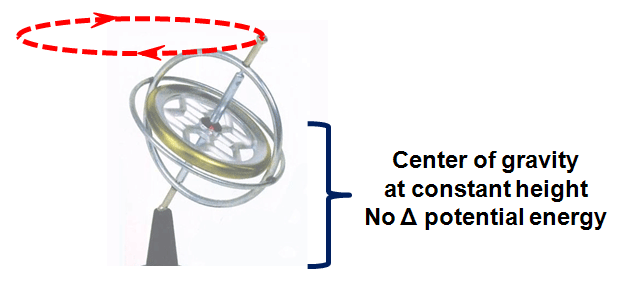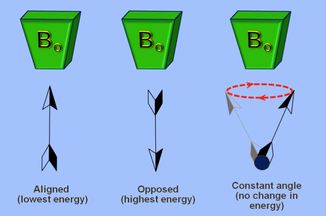The gyroscope pictured above is precessing in a circle parallel to the floor and perpendicular to the earth's gravitational field. Although precessing, the center of mass of the gyroscope remains unchanged in height from the floor. The gyroscope's potential energy is directly proportional to the height of its center of gravity. Since this height remains constant during the precession, no change in energy occurs.
The lowest energy state of the system is when the needle is aligned with Bo. To twist the needle in the opposite direction requires the input of energy (like pushing it with your finger). The opposed state thus has a higher energy level than the aligned state.
During precession, the angle of orientation of the needle with respect to the external field does not change. Hence energy is neither gained nor lost. The Bo field serves to sustain the precession, but does not create the precession nor contribute energy to maintain it.
During precession, the angle of orientation of the needle with respect to the external field does not change. Hence energy is neither gained nor lost. The Bo field serves to sustain the precession, but does not create the precession nor contribute energy to maintain it.
Advanced Discussion (show/hide)»
The above discussion states that precession of a single spin in an external magnetic field occurs as a fundamental interaction and does not require energy input to be maintained.
However, this statement does not apply to precession of the net magnetization (M). At equilibrium, M points along the direction of Bo and does not spontaneously precess (although each of its component spins is precessing). Application of external energy is required to tip M so that it has components in the transverse plane, and continued application of external energy is needed to maintain this precession. Without external energy input, loss of coherence occurs via T1 and T2 processes with return of M to its initial non-precessing position.
References
Butikov E. Precession and nutation of a gyroscope (pdf). Also from this link (accessed 2016).
Butikov E. Precession and nutation of a gyroscope (pdf). Also from this link (accessed 2016).


